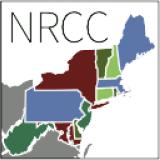Too Much Rain Relief in Some Areas
For more information, visit the Northeast DEWS Dashboard.
Key Points
- Moderate Drought (D1) persisted in areas where rainfall was spotty and light and the more significant thunderstorms moved on quickly. On Long Island, most real-time and 7-day streamflows remained below normal. Western New York real-time streamflows were mixed.
- Abnormally Dry (D0) conditions remained for northern New York near the St. Lawrence Seaway, the Mohawk River, a few counties just north of New York City, and west of the Finger Lakes.
- Most of the Northeast DEWS region will see additional rain in the coming week, with possible continued improvement in drier areas.
- For additional details on the recent extreme rainfall event, please see the "Climate News" section on the Northeast Regional Climate Center homepage.
Current U.S. Drought Monitor map for the Northeast Drought Early Warning System (DEWS) with data valid for July 11, 2023.
The U.S. Drought Monitor depicts the location and intensity of drought across the country using 5 classifications: Abnormally Dry (D0), showing areas that may be going into or are coming out of drought, and four levels of drought (D1–D4).
U.S. Drought Monitor Categories
Abnormally Dry (D0)
Abnormally Dry (D0) indicates a region that is going into or coming out of drought. View typical impacts by state.
Moderate Drought (D1)
Moderate Drought (D1) is the first of four drought categories (D1–D4), according to the U.S. Drought Monitor. View typical impacts by state.
Severe Drought (D2)
Severe Drought (D2) is the second of four drought categories (D1–D4), according to the U.S. Drought Monitor. View typical impacts by state.
Extreme Drought (D3)
Extreme Drought (D3) is the third of four drought categories (D1–D4), according to the U.S. Drought Monitor. View typical impacts by state.
Exceptional Drought (D4)
Exceptional Drought (D4) is the most intense drought category, according to the U.S. Drought Monitor. View typical impacts by state.
Drought Degradation
5-Category Degradation
Drought/dryness has worsened by 5 categories, according to the U.S. Drought Monitor.
4-Category Degradation
Drought/dryness has worsened by 4 categories, according to the U.S. Drought Monitor.
3-Category Degradation
Drought/dryness has worsened by 3 categories, according to the U.S. Drought Monitor.
2-Category Degradation
Drought/dryness has worsened by 2 categories, according to the U.S. Drought Monitor.
1-Category Degradation
Drought/dryness has worsened by 1 category, according to the U.S. Drought Monitor.
Drought Improvement
1-Category Improvement
Drought/dryness has improved by 1 category, according to the U.S. Drought Monitor.
2-Category Improvement
Drought/dryness has improved by 2 categories, according to the U.S. Drought Monitor.
3-Category Improvement
Drought/dryness has improved by 3 categories, according to the U.S. Drought Monitor.
4-Category Improvement
Drought/dryness has improved by 4 categories, according to the U.S. Drought Monitor.
5-Category Improvement
Drought/dryness has improved by 5 categories, according to the U.S. Drought Monitor.
Current U.S. Drought Monitor map for the Northeast Drought Early Warning System (DEWS) with data valid for July 11, 2023.
The U.S. Drought Monitor depicts the location and intensity of drought across the country using 5 classifications: Abnormally Dry (D0), showing areas that may be going into or are coming out of drought, and four levels of drought (D1–D4).
The U.S. Drought Monitor 2-week change map shows where drought/dryness has improved, remained the same, or worsened for the Northeast from June 27 to July 11, 2023.
Yellow/orange hues show areas where conditions worsened, while green hues show improvement.
The U.S. Drought Monitor map is updated weekly on Thursday mornings, with data valid through the previous Tuesday at 7 a.m. Eastern.
U.S. Drought Monitor change maps are released every Thursday morning, with data valid through Tuesday at 7 am Eastern.
Current Conditions
7-Day Streamflow Conditions

Groundwater Levels

State-Reported Conditions and Impacts
Connecticut
Maine
- Maine Drought Task Force
- Impacts:
Massachusetts
- Massachusetts Drought Management Task Force
- Impacts:
- July 6, 2023: The Sun Chronicle – Attleboro Emergency Water Supply Contract
- June 21, 2023: Cape Cod Chronicle – Town Monitoring Water Use
New Hampshire
- New Hampshire Department of Environmental Services: Drought
- Impacts:
- July 7, 2023: The Eagle Times – Farmers Adapting to Weather Variations
- July 3, 2023: New Hampshire Bulletin – Summer Wildfire Threat
- June 28, 2023: Monadnock Ledger-Transcript – Cold Stone Springs Water Facility
New York
- New York State Department of Environmental Conservation (DEC): Drought
- Impacts:
- July 6, 2023: News Channel 13 – The Small Farm Conservation Act Introduced
Rhode Island
- Rhode Island Water Resources Board: Drought Management Program
Vermont
Northeast
- Drought, heat, fire, and smoke:
- July 3, 2023: The New York Times – Economic Impact Lessons
- June 29, 2023: The New York Times – What Do Smoke and High Heat Have in Common?
- June 29, 2023: The New York Times – One Two Punch of Heat and Smoke Is Deadly
Find additional impacts through the National Drought Mitigation Center’s Drought Impact Reporter.
Visit the new Drought.gov state pages for additional maps and resources. Or, find local drought information by address, city or zip code on Drought.gov.
Outlooks
8–14 Day Temperature and Precipitation Outlooks: July 20–26
Near-normal temperatures and above-normal precipitation should keep drought in check throughout the region during this period.


Week 3–4 Temperature and Precipitation Outlooks: July 22–Aug. 4, 2023 (Issued July 7, 2023)
Temperatures will range from below-normal in western New York to above-normal for most of New England. Above-normal precipitation chances should hold off any immediate return to dryness in New England. Areas with existing dryness/drought in the region may improve slightly or remain about the same for the month.


Featured Research
- Jordan I. Christian et al. 2023. "Global projections of flash drought show increased risk in a warming climate," Communications Earth & Environment 4.
Additional Resources
- Look back at previous Northeast DEWS Drought Status Updates
- Your local National Weather Service office
- NOAA Regional Climate Services Monthly Webinar Series (next webinar is on July 27)
- USDA Northeast Climate Hub
- USGS New England and New York Water Science Centers
Contacts for More Information
Sylvia Reeves
Regional Drought Information Coordinator (Northeast DEWS)
NOAA/CIRES/National Integrated Drought Information System (NIDIS)
Email: sylvia.reeves@noaa.gov
Ellen L. Mecray
Regional Climate Services Director, Eastern Region
NOAA/NESDIS/National Centers for Environmental Information
Email: Ellen.L.Mecray@noaa.gov
Prepared By
Sylvia Reeves
NOAA/National Integrated Drought Information System (NIDIS), CIRES
Samantha Borisoff, Jessica Spaccio, Keith Eggleston, Art DeGaetano, Natalie Umphlett
Northeast Regional Climate Center
Ellen Mecray
Regional Climate Services Director, Eastern Region, NOAA
Gardner Bent
USGS New England Water Science Center
In partnership with National Weather Service Offices of the Northeast and State Climate Offices of the Northeast.
This drought status update is issued in partnership between the National Oceanic and Atmospheric Administration (NOAA), U.S. Geological Survey, and the U.S. Department of Agriculture (USDA) to communicate concern for drought expansion and intensification within the Northeast U.S. based on recent conditions and the forecasts and outlooks. NIDIS and its partners will issue future drought status updates as conditions evolve.






